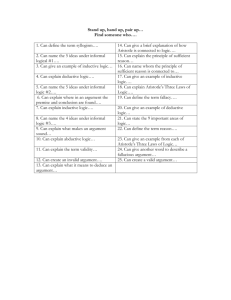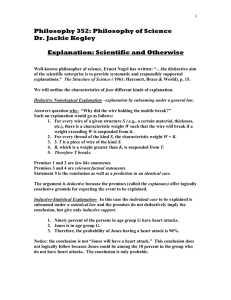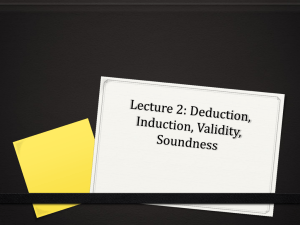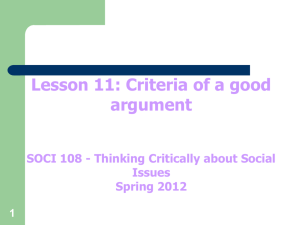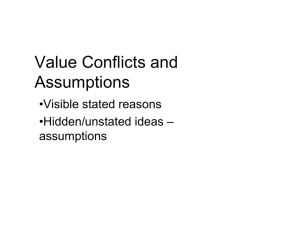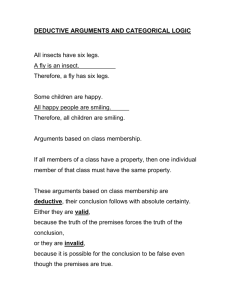Lecture 4 - Basic Logical Arguments
advertisement
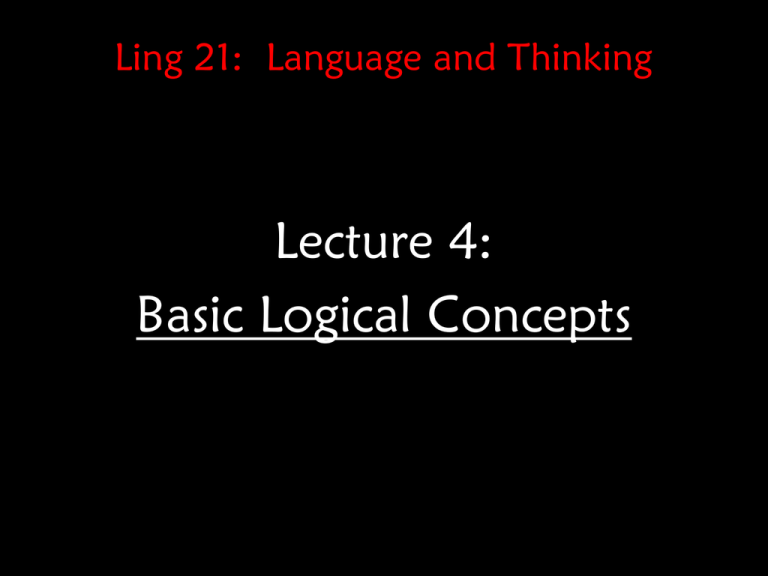
Ling 21: Language and Thinking Lecture 4: Basic Logical Concepts ROAD MAP • After a brief side journey into language and the brain, including: – The physiology of the brain; – The brain and language disorders; and – Sign language and the brain, • We now return to some basic logical concepts Previously on ‘Language & Thinking’, We . . . Defined critical thinking; Identified traits of a critical thinker; Identified some of the barriers to critical thinking; and Defined and analyzed arguments in terms of their component parts (Premises & conclusions). This chapter is EXTREMELY IMPORTANT because . . . • It forms the foundation of EVERYTHING else that is to follow in this course. • If you don’t read and understand this chapter, you will not do well in this course. • So, – read the chapter, – actively participate in the class and – ASK QUESTIONS if you don’t think you get it! BASIC LOGICAL CONCEPTS • Task: To distinguish good arguments from bad • Two questions: – Are the premises true? – Do the premises provide good reasons to accept the conclusion? TWO ARGUMENT TYPES • Deductive arguments (try to) PROVE their conclusions • Inductive arguments (try to) show that their conclusions are PLAUSIBLE or LIKELY DEDUCTIVE ARGUMENTS • Some pigs have wings. All winged things sing. Therefore, some pigs sing. • Everyone has one and only one biological mother. Full sisters have the same biological mother. No one is her own biological mother. Therefore, there is no one whose biological mother is also her sister. EXERCISE: Solve the mysteries, CT pages 54-55. INDUCTIVE ARGUMENTS • Every ruby discovered thus far has been red. So, probably all rubies are red. • Polls show that 87% of 5-year-olds believe in the tooth fairy. Marta is 5 years old. Marta probably believed in the tooth fairy. • Chemically, potassium chloride is very similar to ordinary table salt (sodium chloride). • Therefore, potassium chloride tastes like table salt. THE DIFFERENCE Key: deductive / inductive • If the premises are true the conclusion is necessarily / probably true. • The premises provide conclusive / good evidence for the conclusion. • It is impossible / unlikely for the premises to be true and the conclusion to be false. • It is logically inconsistent / consistent to assert the premises but deny the conclusion. FOUR TESTS • Four tests allow us to identify deductive / inductive arguments – The indicator word test – The strict necessity test – The common pattern test – The principle of charity test INDICATOR WORD TEST Deduction Induction Certainly Definitely Absolutely Conclusively This entails that Probably Likely Plausible Reasonable The odds are that CAUTION! -Arguments may not contain any indicator words. Pleasure is not the same thing as happiness. The occasional self-destructive behavior of the rich and famous confirms this too vividly. (Tom Morris) -Arguers may use indicator words incorrectly. (People very often overstate their cases.) -In these cases, other tests must be used to determine whether an argument is deductive or inductive. The Strict Necessity Test • An argument’s conclusion either follows with strict logical necessity from its premises or it does not. • If an argument’s conclusion does follow with strict logical necessity from its premises, the argument should always be treated as deductive. • if an arguments conclusion does not follow with strict logical necessity from its premises, the argument should normally be treated as inductive. The Strict Necessity Test • Examples: • Alan is a father. Therefore Alan is a male. • Jill is a six-year-old. Therefore, Jill cannot run a mile in one minute flat. COMMON PATTERN TEST • Modus ponens (affirming the antecedent) – If A then B. – A. – Therefore B. (A = antecedent; B = consequent) This is a very common pattern of deductive reasoning. Common Pattern Test • Example (modus ponens) • If we are in Paris, then we are in France. -------A------------------B----------• We are in Paris. --------A--------• Therefore, we are in France. ---------B----------- PRINCIPLE OF CHARITY TEST • When interpreting an unclear argument, always give the speaker / writer the benefit of the doubt. – Fosters good will and mutual understanding in an argument. – Promotes the discovery of truth by insisting that we confront arguments that we ourselves admit to be the strongest and most plausible versions of those arguments. Exceptions to the Strict Necessity Test • An argument in which the conclusion does not follow necessarily from the premises should be treated as deductive if either: 1. The language or context make clear that the arguer intended to offer a logically conclusive argument, but the argument is in fact not logically conclusive; 2. The argument has a pattern of reasoning that is characteristically deductive, and nothing else about the argument indicated clearly that the argument is meant to be inductive. Exceptions to the Strict Necessity Test • Examples 1. Magellan’s ships sailed around the world. It necessarily follows, therefore, that the earth is a sphere. (The arguer intended to offer a logically conclusive argument, so it should be treated as deductive.) 2. If I’m Bill Gates, then I’m mortal. I’m not Bill Gates. Therefore, I’m not mortal. (The argument has a pattern of reasoning characteristic of deductive arguments, so should be treated as deductive.) SUMMARY: How to distinguish deductive from inductive arguments • If the conclusion follows necessarily from the premises = deductive • If the conclusion does not follow necessarily from the premises = inductive, unless – Language indicates it is deductive – Argument has deductive pattern of reasoning • If the argument has a pattern of reasoning that is characteristically deductive = deductive, unless – Clear evidence indicates it is intended to be inductive • If the argument has a pattern of reasoning that is characteristically inductive = inductive unless – Clear evidence indicates it is intended to be deductive • If the argument contains an indicator word • If still in doubt: Principle of Charity 5 COMMON DEDUCTIVE PATTERNS • Hypothetical syllogism • Categorical syllogism • Argument by elimination • Argument based on mathematics • Argument from definition HYPOTHETICAL SYLLOGISM • A syllogism is a three-line argument with two premises, one of which is a conditional. • Modes ponens is a syllogism. • Other syllogisms are: – Chain arguments – Modus tollens (denying the consequent) – Denying the antecedent – Affirming the consequent CHAIN ARGUMENT If A then B. • If B then C. Therefore if A then C. • If you are blue in the face then you are lying. If you are lying then you can’t be my friend. Therefore if you are blue in the face then you can’t be my friend. MODUS TOLLENS • If A then B. Not B. Therefore not A. • If we’re in Sacramento, we’re in California. We’re not in California. Therefore, we’re not in Sacramento. • If you love me, you’ll come with me to Tibet. You will not come with me to Tibet. Therefore you do not love me. DENYING THE ANTECEDENT*** • If A then B. Not A. Therefore not B. *If Tiger Woods won this year’s Masters then he’s a great athlete. Tiger Woods didn’t win this year’s Masters. Therefore, Tiger Woods is not a great athlete. *If Jack comes to the party, Jill will leave. Jack did not come to the party. Therefore Jill did not leave. ***Denying the antecedent is a fallacious deductive pattern AFFIRMING THE CONSEQUENT*** • If A then B. B. Therefore A. *If we are on Neptune then we are in the solar system. We are in the solar system. Therefore we are on Neptune. ***Affirming the consequent is a fallacious deductive pattern Exercise: Identify the argument pattern (ex. 3.2, p. 65) MODUS PONENS (affirming the antecedent): If A then B. A. Therefore B. CHAIN: If A then B. If B then C. Therefore if A then C. MODUS TOLLENS: If A then B. Not B. Therefore not A. *DENYING THE ANTECEDENT: If A then B. Not A. Therefore not B. *AFFIRMING THE CONSEQUENT: If A then B. B. Therefore A. PRINCIPLE OF CHARITY • Attribute an arguer the strongest argument possible. Andy told me he ate at JB’s yesterday. But JB’s was destroyed by a fire a month ago. It is certain therefore that Andy is either lying or mistaken. Caution – The Principle of Charity is a principle of argument interpretation, not a principle of argument repair. CATEGORICAL SYLLOGISM • A three-line argument in which each statement begins with one of the words all, some, or no. – Some pigs have wings All winged things sing. Therefore some pigs sing. ARGUMENT BY ELIMINATION • Rules out various logical possibilities until only a single possibility remains. Either Dutch or Jack or Celia committed the murder. If D or J committed the murder then the weapon was a rope. The weapon was not a rope. Therefore neither D nor J committed the murder. Therefore C committed the murder. MATHEMATICS • The conclusion depends largely or entirely on mathematical calculation or measurement. Light travels at a rate of 186,000 miles per second. The sun is more than 94 million miles from earth. Therefore it takes more than 8 minutes for the sun’s light to reach earth. Caution – not all arguments that make use of numbers and mathematics are deductive. DEFINITION • The conclusion follows from the definition of some key word or phrase in the argument. Josefina is a drummer. Therefore Josefina is a musician. COMMON INDUCTIVE PATTERNS • There are 6 common inductive patterns: – Inductive generalization – Predictive argument – Argument from authority – Causal argument – Statistical argument – Argument from analogy INDUCTIVE GENERALIZATION • A generalization attributes some characteristic to all or most members of a given class. • Information about some members of the class is said to license the generalization. All dinosaur bones discovered thus far have been more than 65 million years old. Therefore probably all dinosaur bones are more than 65 million years old. PREDICTIVE ARGUMENT • A statement about what will (likely) happen in the future is defended with reasons. It has rained in Vancouver every February since records have been kept. Therefore it will probably rain in Vancouver next February. AUTHORITY, CAUSE, STATISTICS • Argument from Authority – The conclusion is supported by citing some presumed authority or witness. • Causal Argument – Asserts or denies that something is the cause of something else. • Statistical Argument – Rests on statistical evidence. ANALOGY • Common Pattern: Two (or more) things are alike in one way. Therefore they are probably alike in some further way. As a man casts off worn-out garments and puts on others that are new, similarly, the soul, casting off worn-out bodies, enters into others, which are new. (Bhagavad-Gita) Exercise: Determine whether arguments are deductive or inductive (ex. 3.3, p. 71-72) VALIDITY • VALID arguments may have false premises and false conclusions! • At issue is the form. If the premises are true the conclusion must be true. All circles are squares. All squares are triangles. Therefore all circles are triangles. All fruits are vegetables. Spinach is a fruit. Therefore spinach is a vegetable. VALIDITY, CONT’D • It is not enough that the conclusion happens to be true. If the conclusion doesn’t follow from the premises by strict logical necessity, a deductive argument is invalid. • All pigs are animals. Wilber is pink. Therefore Wilber is a pig. Exercise: What conclusions follow validly? (ex. 3.4, p. 73-74) SOUNDNESS • A deductive argument is sound if it is valid and has true premises. • A deductive argument with (at least) one untrue premise, valid or invalid, is unsound. Exercise: Determine whether arguments are valid / sound (ex. 3.5 I & II, p. 81-82) INDUCTIVE STRENGTH • A ‘good’ deductive argument is valid. • A ‘good’ inductive argument is strong. • An inductive argument is strong if the conclusion follows probably from the premises. All recent US presidents have been college graduates. It is likely that the next US president will be a college graduate. WEAKNESS • An argument that is not strong is weak. Most US presidents have been men. It is likely that the next US president will be a woman. • In a weak inductive argument, the conclusion does not follow probably from the premises. I dream about monsters. You dream about monsters. Therefore everybody probably dreams about monsters. INDUCTIVE PROBABILITY • The premises and conclusion do not have to be true – The question is: – If the premises were true, would the conclusion follow? • Deductive arguments are either 100% valid or 100% invalid. • Inductive arguments can be somewhat strong, strong, very strong, depending on the degree of support the premises provide for the conclusion. According the National Weather Service, there is a 60% 70% - 90% chance of rain today. It is likely that it will rain today. INDUCTIVE ARGUMENTS • A valid deductive argument with true premises is sound. • A strong inductive argument with true premises is cogent. • An inductive argument that is either weak or has at least one false remise is uncogent. - No US president has been a skateboarding champion. Therefore the next US president will probably not be a skateboarding champion. (Cogent) - All previous US presidents have been rocket scientists. Therefore the next US president will probably be a woman. (Uncogent) - All previous U.S. Presidents have been Democrats. Therefore the next U.S. President will be a Democrat. (Uncogent) INDUCTIVE ARGUMENTS • Exercise: Determine whether arguments are cogent or uncogent (ex. 3.5 III, p. 82-83) Summary of Argument Types Deductive Valid Sound Unsound Inductive Invalid (all are unsound) Cogent Strong Weak (all are uncogent) Uncogent MEMORIZE THESE DIAGRAMS ! ! ! Culminating Activity • Exercise 3.5 IV, Page 83: Determine whether the arguments are deductive or inductive. If the argument is deductive, determine whether it is valid or invalid. If the argument is inductive, determine whether it is strong or weak.
